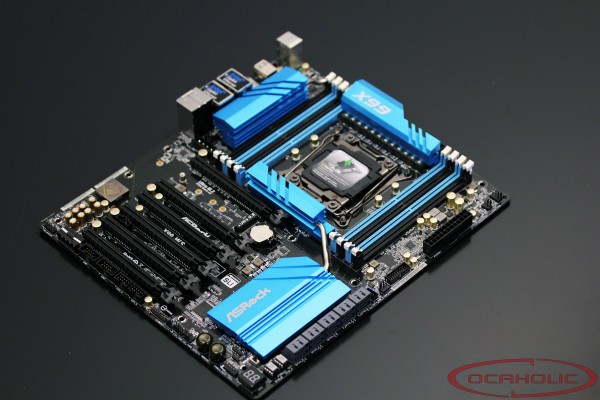ASRock X99 WS Review
Published by Hiwa Pouri on 29.08.14Layout
At a first glance the ASRock X99 WS leaves a very good impression with its good looking design. The manufacturer decided to go for a combination of black and blue, which suites nicely and in the end you get an aesthetic looking product. The layout itself is well thought and there is for example plenty of space around the CPU socket to install even todays largest CPU coolers. The fact that there are SATA connectors which have been angled by 90 degrees allows for an easy installation of oversized graphics cards. Meanwhile ASRock is using very similarly shaped cooling blocks on all motherboards in order to unify the design language. The only thing that gets changed is the color.The ASRock X99 WS comes with a digital 12+4 phase power design, whereas the CPU is backed up by twelve phases and the memory by four. Like we've already explained on the features page ASRock is making use of an extensive solution. There are for instance Dual-Stack MOSFETs, NexFET MOSFETs as well as 12K Platinum caps on this motherboard. The Dual-Stack MOSFETs are taking care of stable and efficient current delivery to the CPU and compared to standard MOSFETs the offer a significantly lower RDS(on) value of just 1.2 milliohm. The memory gets backed-up by NexFET MOSFETs, which also offer a very low ROD(on) value of 2.9 milliohm. Last but definitely not least there 12K Platinum Caps that are good for no less than 12'000 hours of on time.
Totally you'll find eight DIMM-slots on the ASRock X99 WS. Officially supported are DDR4, 2933+(OC) / 2800(OC) / 2400(OC) / 2133 MHz. There is engough space between the DIMM-slots and the CPU socket which means that you wont encounter compatibility problems with big coolers even when you choose to install RAM with big heatspreaders. Also supported are Xtreme Memory Profiles (XMP) in version 2.0.
On the X99 WS PCH as well as current converters got separate cooling blocks and also the chips in between CPU socket and first PCI Express 3.0 slot received their own cooling element. ASRock decided to connect PCH and the block between CPU socket and first PCI Express 3.0 slot with a heatpipe and also the two blocks covering the VRM area are connected via a heatpipe. Other than that the weight of this board is quite high, which is also partially due to cooling blocks. Subjectively speaking a high weight is a first indicator for a quality motherboard.
| Navigate through the articles | |
EVGA X99 Classified Review
 |
|
|
|







